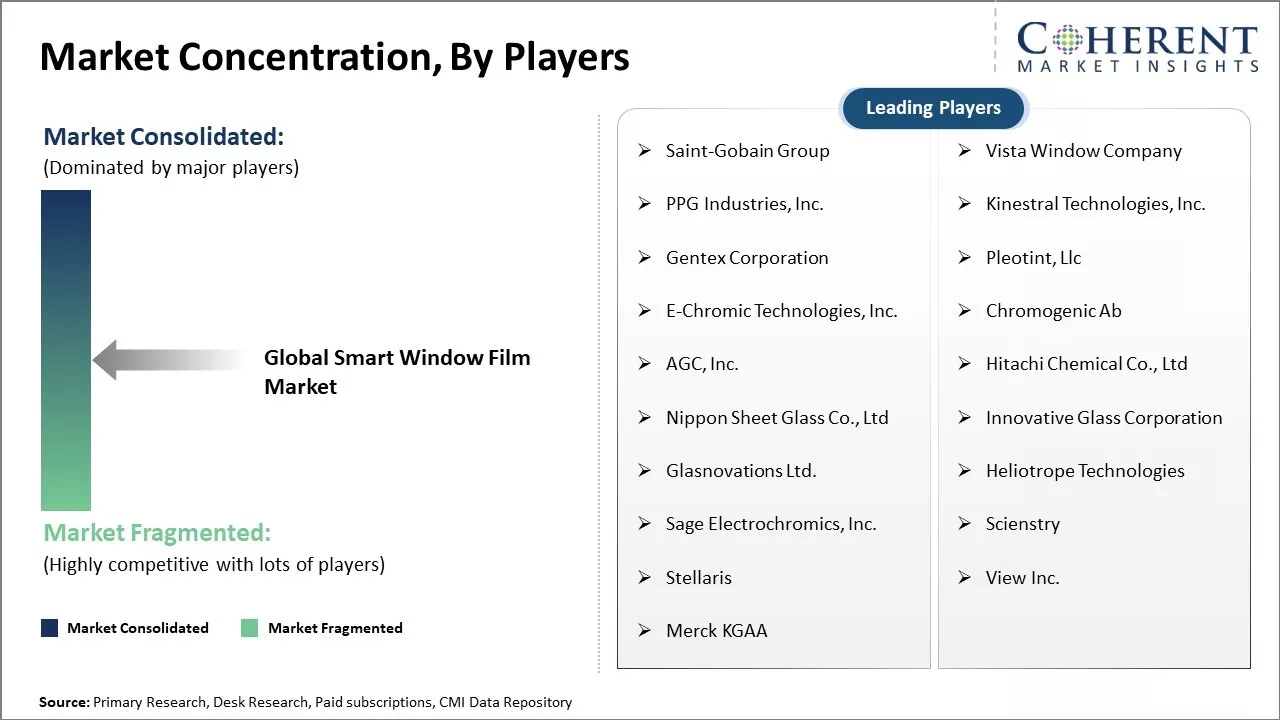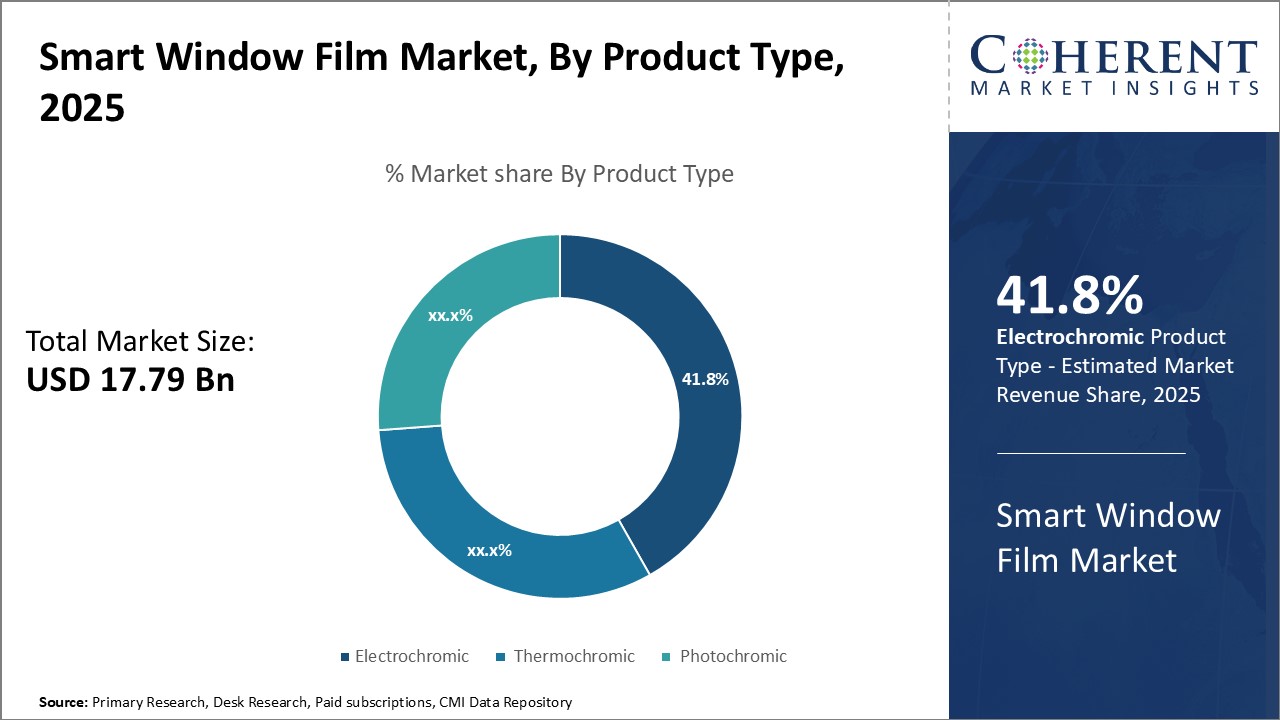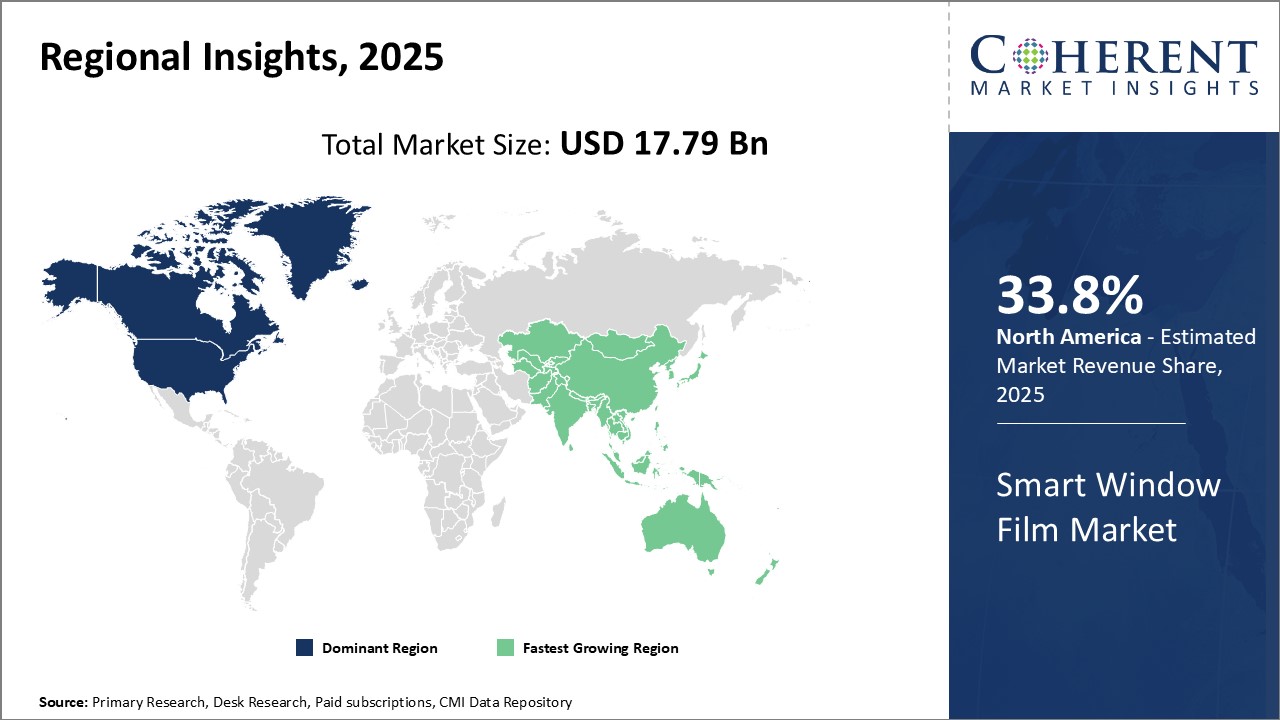Smart Window Film Market Size and Trends
The smart window film market is estimated to be valued at USD 17.79 Bn in 2025 and is expected to reach USD 32.54 Bn by 2032, exhibiting a compound annual growth rate (CAGR) of 9.0% from 2025 to 2032.

Discover market dynamics shaping the industry: Download Free Sample
Smart window films help regulate heat and glare entering buildings, which leads to improved energy efficiency and reduced electricity bills. Rising construction of green commercial buildings and increasing focus on energy conservation are some key factors driving the demand for smart window films. Smart window films offer various benefits such as ability to switch tints and change transparency levels automatically or semi-automatically with the sun's movement. This makes buildings more energy efficient and improves occupant comfort. Growth in the construction industry along with rising consumer awareness about energy efficient technologies are expected to boost the smart window films market in the coming years.
Drivers of the Market:
Expanding construction sector
The global construction industry has been witnessing steady growth over the past few years and this growth is expected to continue in the coming years. Various factors such as booming real estate markets, rising commercial and industrial construction, and infrastructure investments by governments are driving the growth of the construction sector worldwide. As more number of residential and commercial buildings are being constructed annually, the demand for various building materials and components is also increasing.
Smart window films have emerged as an important product that is being increasingly used in various construction projects. These window films help in improving the energy efficiency of buildings by reducing the solar heat gain and lowering energy costs of cooling and heating. They also offer benefits such as glare control and enhanced security. Many builders and architects are recognizing the advantages of using smart window films and are specifying them in new construction projects. The growing construction output is leading to higher volume demand from this end-use sector. In particular, commercial projects such as office buildings, hospitals, and hotels are major adopters of smart window films as they look for ways to lower energy bills and improve occupant comfort through daylighting and passive heating/cooling effects.
Market Concentration and Competitive Landscape

Get actionable strategies to beat competition: Download Free Sample
Rising consumer preference for eco-friendly buildings
There is a rising trend where consumers are preferring homes and offices that are more energy-efficient and eco-friendly. Both commercial and residential buyers are willing to pay a premium for properties that have adopted green building practices and use sustainable materials. This change in consumer attitude has been propelled by growing environmental awareness and need to reduce carbon footprint of buildings. Many countries have also introduced various incentives and rating systems to encourage the construction of green buildings.
Under this scenario, smart window films have emerged as a popular product amongst architects and builders as they help new properties to gain credits for energy efficiency under green building rating systems such as LEED. These films allow the optimal use of daylight, reducing strain on eyes as well as lowering energy costs associated with artificial lighting. Their ability to block solar heat gain also helps lower air conditioning load and costs in hot weather regions. Many discerning home buyers are now expressly demanding the use of smart films on windows as they want to live in a greener home environment. This evolving consumer preference for eco-friendly buildings therefore presents new growth opportunities for smart window film manufacturers.
Key Takeaways from Analyst:
Major drivers of growth include rising demand for energy efficiency and glare control solutions in the construction industry. Smart window films allow natural light transmission and heat control, thereby reducing energy costs for heating, ventilation, and air conditioning. However, the market also faces some challenges. High production costs associated with transitioning to electrochromic technologies may restrain the revenue growth to some extent. Also, the lack of standardization regarding performance guidelines limits the widespread application of smart window films.
North America presently dominates due to stricter green building codes and rising renovations & remodels activity. Within the region, the U.S. commercial sector leverages smart window benefits the most. Meanwhile, the Asia Pacific market is estimated to expand at an impressive pace. Rapid infrastructure growth and smart city initiatives in China and India are primed to drive film consumption.
Overall, as sustainability becomes a major priority, the prospects for smart window films look promising. Film manufacturers are innovating to provide energy-efficient and easy installation solutions. Partnerships between players across the value chain could help in greater commercialization.
Challenges: High initial investment cost
The high initial investment cost required for the installation of smart window films is a major challenge, restricting the growth of the smart window film market. Smart window films are technologically advanced products that use various technologies like low emissive coatings, suspended particle devices (SPDs), electrochromic, thermochromic and polymer dispersed liquid crystals to automatically tint the windows and control the amount of heat, glare, and light passing through. However, these sophisticated technologies come at a higher price compared to traditional window films.
Opportunities: Emerging applications in automotive sector
The automotive sector is poised to benefit significantly from emerging applications of smart window films. As electric and autonomous vehicles gain widespread adoption in the coming years, smart window films can play an important role in enhancing the safety, comfort, and functionality for passengers. Smart window films can be integrated into windshields, side windows, sunroofs, and rear windows of vehicles. They have the ability to instantly switch between dark and light states depending on electrical current applied, and can regulate temperature and sunlight entering the vehicle. This provides ample opportunities to automate window tinting based on driving conditions, location-based requirements and ambient light conditions. For example, the film can automatically darken when parked in hot weather, and then lighten before the driver enters the vehicle. This significantly reduces heat accumulation and improves passenger comfort with minimal manual intervention.

Discover high revenue pocket segments and roadmap to it: Download Free Sample
Insights by product type: Electrochromic Drives Growth in the Smart Window Film Market Product Segment
Within the smart window film market's product type segment, electrochromic technology segment is expected to contribute 41.8% of the market share in 2025, due to its superior performance and energy efficiency. Electrochromic films utilize electrically controlled tints that can be precisely adjusted to allow optimal light transmission for any environment. This precision control allows buildings to maintain comfortable temperatures with minimized energy usage year-round. Compared to alternative technologies, electrochromic offers the fastest switching speeds of just a few seconds between any level of tint. Its instant transitions create a seamless environment that is easier on the eyes.
Electrochromic's reliability has also accelerated its popularity. The films maintain consistent tinting for over 20 years with no degradation in the glass or electronics. This longevity eliminates maintenance costs and provides a greater return on investment than replacement-required alternatives. As sustainability becomes increasingly important, electrochromic is also more environment-friendly through its energy savings.
As the technology continues to improve, its advantages over competing options will grow. Manufacturers are working to make the films even more energy-efficient and affordable. Dual-pane insulated glass units with electrochromic are being developed to boost performance further. Meanwhile, mass production is decreasing manufacturing expenses. Both developments will drive higher adoption rates across the commercial and residential markets seeking sustainable window solutions. Overall, electrochromic's unique value proposition centered around optimal energy management has made it the top choice in the product segment.
Insights by application: Commercial Leads the Application Segment of the Smart Window Film Market
The commercial segment is expected to dominate the application segment of the smart window film market with 32.7% of the market share in 2025. Numerous factors have propelled its growth over other end uses. Large office buildings, healthcare facilities, educational campuses, and other commercial properties often have significant window surface areas. Their vast glazed facades lead to substantial cooling, heating, and lighting costs if not properly managed. Smart window films enable cutting-edge environmental control optimized for various commercial settings.
Commercial customers also focus on enhancing occupant comfort, productivity, and brand image - major priorities that smart films address. Their ability to dynamically tune daylight and heat levels based on interior and exterior conditions creates a more pleasant environment for employees and visitors. Studies show controlled light and temperature can boost performance by 15-20%. Meanwhile, the films showcase an organization's commitment to sustainability through energy reductions. These benefits have made commercial clients at the forefront of adoption. Revenue opportunities are also greater amidst the commercial segment's typically larger budgets and willingness to invest in advanced building technologies. Window film vendors can implement comprehensive solutions at massive properties to maximize savings. Such large-scale projects deliver greater profits. Overall commercial has been a smart window film trailblazer due to the sector's unique needs, priorities, and financial capabilities, driving widespread implementation.
Regional Insights

Need a Different Region or Segment? Download Free Sample
North America has been the largest regional market for smart window films globally. The region is expected to account for 33.8% of the market share in 2025. The country has a well-established construction industry due to its high disposable incomes. Commercial buildings account for majority of the demand due to the robust presence of corporate offices across various major cities. Stringent government regulations regarding energy efficiency in buildings further drive the uptake of these films. With green building codes and standards mandating the use of smart glazing solutions, many architectural and construction firms have incorporated smart window films in their new projects. Leading players from the U.S, and Canada also actively promoting the benefits of these films such as enhanced occupant comfort and reduced energy costs.
The Asia Pacific region has emerged as the fastest growing market for smart window films in recent years. Countries like China, India, Singapore, and Malaysia are rapidly investing in infrastructure development which has augmented the sales of window films. The real estate boom across developing Asian economies is catalyzing the installation of smart glazing across residential and commercial complexes. Various state-run construction agencies actively support use of energy saving solutions through incentive schemes and subsidies. This has motivated builders to adopt smart window films on a large scale. Additionally, several international construction giants have established their headquarters in the Asia Pacific region which creates steady aftermarket demand. Export activity of smart window films is also gaining momentum with China exporting its brands to other Southeast Asian nations.
Market Report Scope
Smart Window Film Market Report Coverage
| Report Coverage | Details | ||
|---|---|---|---|
| Base Year: | 2024 | Market Size in 2025: | USD 17.79 Bn |
| Historical Data for: | 2020 To 2024 | Forecast Period: | 2025 To 2032 |
| Forecast Period 2025 to 2032 CAGR: | 9.0% | 2032 Value Projection: | USD 32.54 Bn |
| Geographies covered: |
|
||
| Segments covered: |
|
||
| Companies covered: |
Saint-Gobain Group , Vista Window Company, PPG Industries, Inc., Kinestral Technologies, Inc., Gentex Corporation, Pleotint, Llc , E-Chromic Technologies, Inc. , Chromogenic Ab, AGC, Inc. , Hitachi Chemical Co., Ltd, Nippon Sheet Glass Co., Ltd, Innovative Glass Corporation, Glasnovations Ltd., Heliotrope Technologies, Sage Electrochromics, Inc., Scienstry, Stellaris, View Inc., and Merck KGAA |
||
| Growth Drivers: |
|
||
| Restraints & Challenges: |
|
||
Uncover macros and micros vetted on 75+ parameters: Get instant access to report
Smart Window Film Industry News
- In February 2024, ARMOR GROUP unveiled its new "smart films" initiative, marking a significant advancement in the field of innovative materials. This new activity focuses on the development and application of smart films that can enhance various surfaces with advanced functionalities.
*Definition: Smart window film is applied to existing windows to control the amount of light, heat, and glare that passes through. The smart window film market encompasses all types of window films that can change their optical properties or tint in response to external stimuli such as temperature, voltage, or light. Some key products under this market include electrochromic, photochromic and thermochromic window films that help in improving energy efficiency of buildings by reducing the need for artificial lighting and heating/cooling.
Market Segmentation
- Product Type Insights (Revenue, USD Bn, 2020 - 2032)
-
- Electrochromic
- Thermochromic
- Photochromic
- Application Insights (Revenue, USD Bn, 2020 - 2032)
-
- Residential
- Commercial
- Automotive
- Others (Transportation, etc.)
- Regional Insights (Revenue, USD Bn, 2020 - 2032)
-
- North America
- U.S.
- Canada
- Latin America
- Brazil
- Argentina
- Mexico
- Rest of Latin America
- Europe
- Germany
- U.K.
- Spain
- France
- Italy
- Russia
- Rest of Europe
- Asia Pacific
- China
- India
- Japan
- Australia
- South Korea
- ASEAN
- Rest of Asia Pacific
- Middle East & Africa
- GCC Countries
- Israel
- Rest of Middle East & Africa
- North America
- Key Players Insights
- Saint-Gobain Group
- Vista Window Company
- PPG Industries, Inc.
- Kinestral Technologies, Inc.
- Gentex Corporation
- Pleotint, Llc
- E-Chromic Technologies, Inc.
- Chromogenic Ab
- AGC, Inc.
- Hitachi Chemical Co., Ltd
- Nippon Sheet Glass Co., Ltd
- Innovative Glass Corporation
- Glasnovations Ltd.
- Heliotrope Technologies
- Sage Electrochromics, Inc.
- Scienstry
- Stellaris
- View Inc.
- Merck KGAA
Share
Share
About Author
Yash Doshi is a Senior Management Consultant. He has 12+ years of experience in conducting research and handling consulting projects across verticals in APAC, EMEA, and the Americas.
He brings strong acumen in helping chemical companies navigate complex challenges and identify growth opportunities. He has deep expertise across the chemicals value chain, including commodity, specialty and fine chemicals, plastics and polymers, and petrochemicals. Yash is a sought-after speaker at industry conferences and contributes to various publications on topics related commodity, specialty and fine chemicals, plastics and polymers, and petrochemicals.
Missing comfort of reading report in your local language? Find your preferred language :
Transform your Strategy with Exclusive Trending Reports :
Frequently Asked Questions
EXISTING CLIENTELE
Joining thousands of companies around the world committed to making the Excellent Business Solutions.
View All Our Clients
